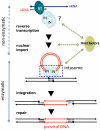Non-Enzymatic Functions of Retroviral Integrase: The Next Target for Novel Anti-HIV Drug Development
- PMID: 22016749
- PMCID: PMC3192317
- DOI: 10.3389/fmicb.2011.00210
Non-Enzymatic Functions of Retroviral Integrase: The Next Target for Novel Anti-HIV Drug Development
Abstract
Integrase (IN) is a retroviral enzyme that catalyzes the insertion of viral DNA (vDNA) into host chromosomal DNA, which is necessary for efficient viral replication. The crystal structure of prototype foamy virus IN bound to cognate vDNA ends, a complex referred to as the intasome, has recently been resolved. Structure analysis of the intasome revealed a tetramer structure of IN that was required for its catalytic function, and also showed the inhibitory mechanism of the IN inhibitor. Genetic analysis of IN has revealed additional non-enzymatic roles during viral replication cycles at several steps other than integration. However, the higher order structure of IN that is required for its non-enzymatic functions remains to be delineated. This is the next major challenge in the field of IN structural biology hoping to be a platform for the development of novel IN inhibitors to treat human immunodeficiency virus type 1 infectious disease.
Keywords: Gemin2; HIV-1; intasome; integrase; pol; reverse transcriptase; reverse transcription.
Figures


Similar articles
-
Retroviral integrase protein and intasome nucleoprotein complex structures.World J Biol Chem. 2017 Feb 26;8(1):32-44. doi: 10.4331/wjbc.v8.i1.32. World J Biol Chem. 2017. PMID: 28289517 Free PMC article. Review.
-
Retroviral intasome assembly and inhibition of DNA strand transfer.Nature. 2010 Mar 11;464(7286):232-6. doi: 10.1038/nature08784. Epub 2010 Jan 31. Nature. 2010. PMID: 20118915 Free PMC article.
-
Structure-based modeling of the functional HIV-1 intasome and its inhibition.Proc Natl Acad Sci U S A. 2010 Sep 7;107(36):15910-5. doi: 10.1073/pnas.1002346107. Epub 2010 Aug 23. Proc Natl Acad Sci U S A. 2010. PMID: 20733078 Free PMC article.
-
Retroviral prototype foamy virus intasome binding to a nucleosome target does not determine integration efficiency.J Biol Chem. 2021 Jan-Jun;296:100550. doi: 10.1016/j.jbc.2021.100550. Epub 2021 Mar 18. J Biol Chem. 2021. PMID: 33744295 Free PMC article.
-
Structural insights into the retroviral DNA integration apparatus.Curr Opin Struct Biol. 2011 Apr;21(2):249-56. doi: 10.1016/j.sbi.2010.12.005. Epub 2011 Feb 1. Curr Opin Struct Biol. 2011. PMID: 21277766 Review.
Cited by
-
Structural biology for virus research.Front Microbiol. 2012 Mar 13;3:91. doi: 10.3389/fmicb.2012.00091. eCollection 2012. Front Microbiol. 2012. PMID: 22419916 Free PMC article. No abstract available.
-
Critical Contribution of Tyr15 in the HIV-1 Integrase (IN) in Facilitating IN Assembly and Nonenzymatic Function through the IN Precursor Form with Reverse Transcriptase.J Virol. 2016 Dec 16;91(1):e02003-16. doi: 10.1128/JVI.02003-16. Print 2017 Jan 1. J Virol. 2016. PMID: 27795445 Free PMC article.
-
Cis-Allosteric Regulation of HIV-1 Reverse Transcriptase by Integrase.Viruses. 2022 Dec 21;15(1):31. doi: 10.3390/v15010031. Viruses. 2022. PMID: 36680070 Free PMC article.
-
Inhibiting the HIV integration process: past, present, and the future.J Med Chem. 2014 Feb 13;57(3):539-66. doi: 10.1021/jm400674a. Epub 2013 Sep 25. J Med Chem. 2014. PMID: 24025027 Free PMC article.
-
Allosteric inhibition of HIV-1 integrase activity.Curr Opin Chem Biol. 2013 Jun;17(3):339-45. doi: 10.1016/j.cbpa.2013.04.010. Epub 2013 May 3. Curr Opin Chem Biol. 2013. PMID: 23647983 Free PMC article. Review.
References
-
- Burke C. J., Sanyal G., Bruner M. W., Ryan J. A., Lafemina R. L., Robbins H. L., Zeft A. S., Middaugh C. R., Cordingley M. G. (1992). Structural implications of spectroscopic characterization of a putative zinc finger peptide from HIV-1 integrase. J. Biol. Chem. 267, 9639–9644 - PubMed
LinkOut - more resources
Full Text Sources

